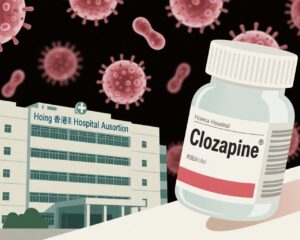Background
Spinal muscular atrophy (SMA) is a genetic neuromuscular disorder caused by deficiency of survival motor neuron (SMN) protein. SMN-restoring therapies—nusinersen (Spinraza), risdiplam (Evrysdi), and onasemnogene abeparvovec (Zolgensma)—have transformed outcomes for many patients, reducing mortality and improving motor milestones. Despite these advances, many patients, particularly those who remain non‑ambulatory (commonly classified as type 2 or non‑ambulatory type 3), continue to experience substantial weakness and functional limitations.
Apitegromab is a fully human monoclonal antibody developed by Scholar Rock that selectively inhibits myostatin activation. Myostatin (growth differentiation factor 8, GDF‑8) is a negative regulator of muscle growth; by blocking its activation, apitegromab aims to increase muscle mass and improve strength and function. The SAPPHIRE trial (NCT05156320) evaluated whether adding apitegromab to standard-of-care SMN‑targeting therapies could yield additional functional benefit in non‑ambulatory children and young adults with type 2 or type 3 SMA.
Study design and methods
SAPPHIRE was a randomized, double‑blind, placebo‑controlled phase 3 trial conducted at 48 centres across Europe and the USA. Key eligibility criteria included: age 2–21 years; genetically confirmed SMN‑deficient non‑ambulatory type 2 or type 3 SMA; estimated life expectancy >2 years; Hammersmith Functional Motor Scale–Expanded (HFMSE) score between 10 and 45; and ongoing treatment with nusinersen for at least 10 months or risdiplam for at least 6 months at screening.
Randomization and dosing:
– Participants aged 2–12 years were randomized 1:1:1 to apitegromab 20 mg/kg, apitegromab 10 mg/kg, or placebo every 4 weeks.
– Participants aged 13–21 years were randomized 2:1 to apitegromab 20 mg/kg or placebo every 4 weeks.
Blinding was maintained for participants, caregivers, investigators, and site staff. The primary endpoint was change from baseline in HFMSE at 12 months in the younger cohort (2–12 years), assessed in a modified intention‑to‑treat population (participants who received at least one dose and had at least one post‑baseline HFMSE assessment). Primary statistical comparisons used a mixed‑effects model for repeated measures (MMRM) to compare combined apitegromab doses (20 + 10 mg/kg) versus placebo, and apitegromab 20 mg/kg versus placebo. Safety analyses included adverse events (AEs), vital signs, cardiac assessments, labs, and concomitant medications.
Key results
Between March 28, 2022, and September 4, 2024, 188 participants were enrolled: 156 aged 2–12 years and 32 aged 13–21 years. Of these, 128 received apitegromab and 60 received placebo.
Primary efficacy (2–12 years):
– At 12 months, the least squares mean (LS mean) change from baseline in HFMSE for the combined apitegromab group versus placebo produced an LS mean difference of 1.8 points (95% CI 0.30 to 3.32; p = 0.019). Reported LS means were 0.6 for apitegromab versus −1.2 for placebo.
– For the prespecified comparison of apitegromab 20 mg/kg versus placebo, the LS mean difference was 1.4 points (95% CI −0.34 to 3.13; p = 0.11); LS means were 0.2 for 20 mg/kg versus −1.2 for placebo.
Safety:
– The overall incidence and severity of adverse events were similar between apitegromab and placebo and were consistent with expected events in patients with SMA and those receiving background SMA therapies.
– The most frequent AEs (apitegromab vs placebo) included pyrexia (26% vs 28%), nasopharyngitis (25% vs 23%), cough (23% vs 20%), vomiting (23% vs 17%), upper respiratory tract infection (22% vs 30%), and headache (21% vs 20%).
– No patients discontinued treatment due to adverse events. Cardiac monitoring and laboratory assessments revealed no unexpected safety signals in this 12‑month window.
Interpretation and clinical meaning
SAPPHIRE demonstrates that adding apitegromab to established SMN‑restoring therapies produced a statistically significant improvement in HFMSE at 12 months when both apitegromab dose groups were pooled (1.8‑point LS mean difference versus placebo). However, the higher 20 mg/kg dose alone did not reach statistical significance versus placebo in the primary analysis.
How should these findings be interpreted clinically?
– Statistical versus clinical significance: Although the pooled effect reached statistical significance (p = 0.019), the magnitude of benefit—about 1.8 HFMSE points—is modest. Published estimates of the minimal clinically important difference (MCID) for HFMSE in SMA vary by age, baseline function and study design; some studies suggest MCID values around 2–3 points, but there is no universally accepted threshold. Therefore, while the result indicates a measurable treatment effect, clinicians and families should weigh whether a change of this size translates into meaningful day‑to‑day functional improvement for an individual.
– Dose considerations: The pooled analysis (10 + 20 mg/kg) was positive, but the 20 mg/kg arm alone was not statistically significant. That pattern raises questions about dose–response, sample size, or variability. Detailed subgroup analyses, longer follow‑up, and pooled data with other studies (for example, the phase 2 TOPAZ trial) will help clarify the optimal dosing strategy.
– Add‑on therapy rationale: Importantly, this trial enrolled patients who were already receiving SMN‑targeting therapies. Apitegromab represents a complementary, muscle‑targeted approach designed to augment strength and function rather than address SMN deficiency. The SAPPHIRE data support the concept that combining SMN restoration with therapies that directly improve muscle biology can provide additional benefit.
Safety considerations
Apitegromab was generally well tolerated over 12 months, with adverse event rates and types similar to placebo and consistent with background SMA care. Of note:
– There were no clinically meaningful cardiac safety signals reported in the trial summary; cardiac monitoring was part of routine safety assessments given theoretical concerns with systemic muscle growth modulators.
– No discontinuations due to adverse events occurred, which supports tolerability in this population.
Longer‑term safety: As with any therapy that modifies muscle biology, long‑term follow‑up will be important to assess durability of effect and to monitor for potential delayed adverse effects. Larger and longer datasets will better define safety in different age groups and in combination with various SMN therapies.
Strengths and limitations
Strengths:
– Randomized, double‑blind, placebo‑controlled design across multiple international centres.
– Enrollment of patients already on established SMN therapies, reflecting real‑world additive use.
– Use of an established functional scale (HFMSE) that is familiar to clinicians and researchers in SMA.
Limitations:
– Effect size at 12 months was modest; clinical meaningfulness for individuals may vary and requires careful interpretation.
– The trial was powered for predefined comparisons in the younger cohort; the older cohort (13–21 years) was smaller and presented separately.
– Follow‑up was 12 months in the primary analysis; longer observation is needed to assess durability and rare safety events.
– The study population was limited to non‑ambulatory patients with HFMSE 10–45, so results do not directly apply to ambulatory individuals, infants, or those with very low baseline scores.
Practical implications for clinicians and families
– Adjunctive strategy: For clinicians managing children with non‑ambulatory SMA who are already receiving nusinersen or risdiplam, apitegromab offers a mechanistically distinct adjunctive approach focused on muscle improvement. The choice to use such therapy should consider the modest average benefit seen at 12 months, patient goals, burden of additional infusions, and access/cost considerations.
– Shared decision‑making: Families should be informed that the trial showed a small average motor improvement compared with placebo when both doses were pooled, but that individual responses vary. Discuss expectations transparently—some patients may experience meaningful gains, others smaller or no measurable change.
– Monitoring: If apitegromab is used in practice, clinicians should monitor motor function with validated scales (HFMSE or other appropriate measures), respiratory status, swallowing/bulbar function, and routine safety labs and cardiac assessments per product guidance.
Unanswered questions and next steps
Key areas for further research include:
– Longer‑term efficacy and safety beyond 12 months to determine whether gains increase, plateau, or are sustained.
– Identification of responders: biomarkers or clinical predictors of who benefits most (age, baseline strength, SMN2 copy number, duration on SMN therapy).
– Functional and patient‑centered outcomes: respiratory metrics, bulbar function, quality of life, caregiver burden, and patient‑reported outcomes to complement HFMSE changes.
– Dose optimization: clarifying the relative contributions of the 10 mg/kg and 20 mg/kg doses and whether different regimens yield larger, durable benefits.
– Regulatory and health‑economic analyses to inform access and reimbursement decisions.
Conclusions
The SAPPHIRE phase 3 trial provides evidence that apitegromab, when added to existing SMN‑augmenting therapies in non‑ambulatory children with type 2 or type 3 SMA, produced a small but statistically significant improvement in motor function at 12 months when both doses were combined. The higher 20 mg/kg dose did not reach statistical significance by itself. Apitegromab was generally well tolerated and did not produce new safety signals in this 12‑month analysis. These results reinforce the therapeutic concept of combining SMN restoration with muscle‑targeted therapies to further improve outcomes for people with SMA, while underscoring the need to interpret modest average gains in the context of individual patient goals and longer‑term data.
Practical reference
Crawford TO, Servais L, Mercuri E, et al.; SAPPHIRE Study Group. Safety and efficacy of apitegromab in nonambulatory type 2 or type 3 spinal muscular atrophy (SAPPHIRE): a phase 3, double‑blind, randomised, placebo‑controlled trial. Lancet Neurol. 2025 Sep;24(9):727‑739. doi:10.1016/S1474‑4422(25)00225‑X. Trial registered at ClinicalTrials.gov: NCT05156320. Funded by Scholar Rock.
For clinicians and families considering apitegromab, discussions should include the modest average benefit seen, the tolerability profile, monitoring requirements, and realistic functional goals for the individual patient.


